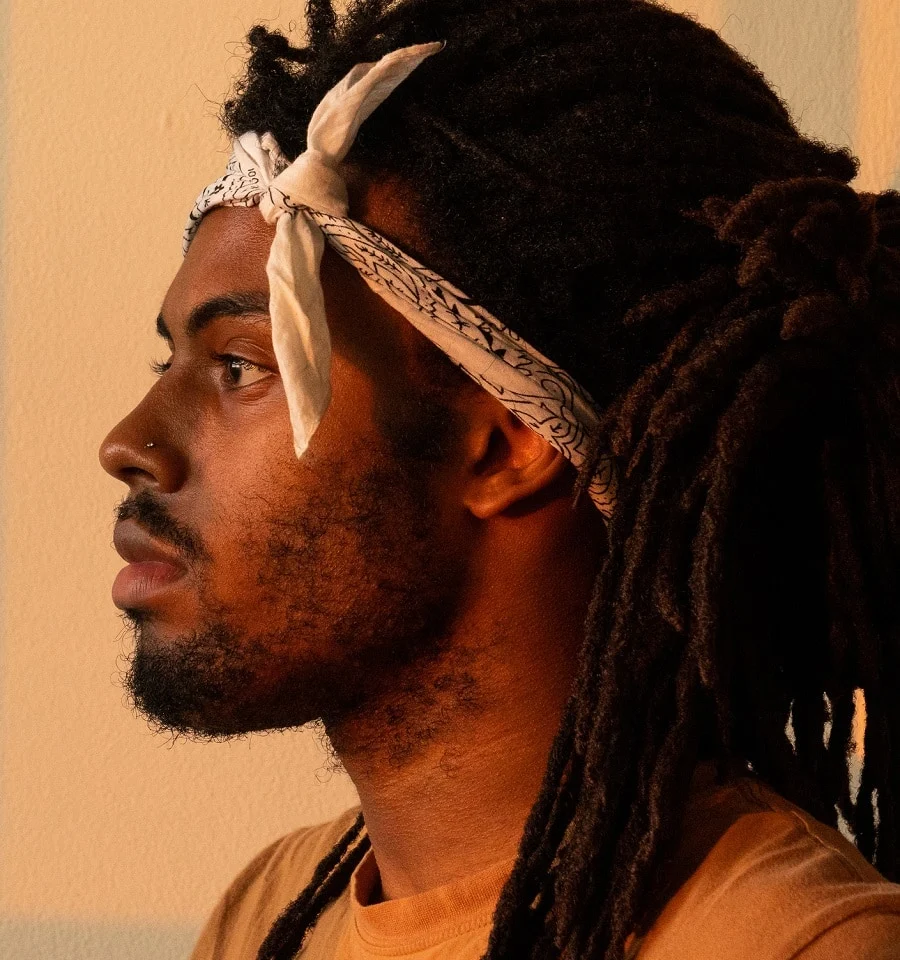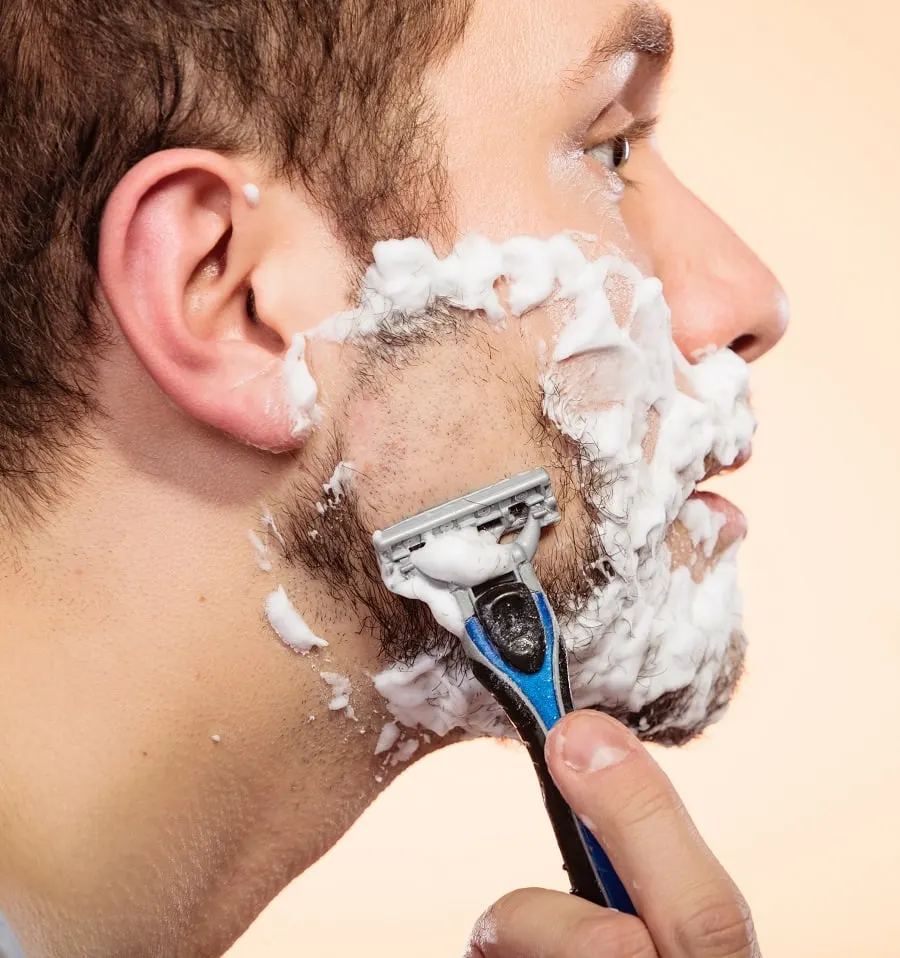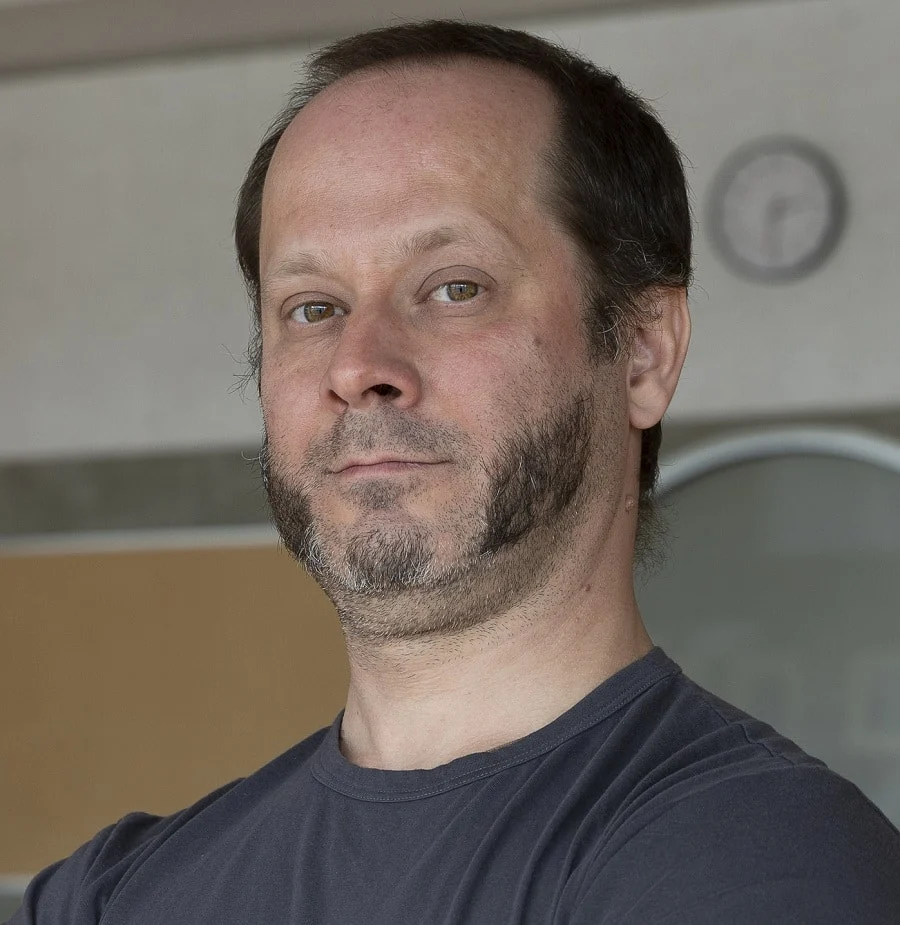Having a beard that’s full and even is something to be proud of. But not all of us have the genes to grow one. Some guys end up with patchy beards that are thick in one spot and almost bare in another.
There could be lots of reasons behind a patchy beard. Some of these can be fixed with a bit of maintenance, while others can be hidden with smart beard styling.
So, if there’s a chance to fix a patchy beard, how to do it? And if it is not possible to fix the patchy beard growth, how do you style it to look less uneven? We have all your answers.
What Is Patchy Beard?

If there are areas on your face where hair doesn’t grow, or it has less density than in other areas, it is called a patchy beard.
Here are a few specific examples of what could be considered a patchy beard:
- Bald spots: If there are bald areas on your face where no hair grows at all, this might be considered too patchy. Bald spots can sometimes be filled in by letting the hair from surrounding areas grow longer and then styling it to cover the patch. But this isn’t always possible, depending on the size and location of the spot.
- Uneven density: Different thicknesses of hair on your cheeks, chin, jawline, or other areas of your face might create an uneven or patchy look. This can be fixed by trimming the denser areas to match the thinner areas.
- Irregular growth patterns: Faster facial hair growth on some parts of your face makes facial hair on other parts look shorter and uneven. This is also considered a patchy beard growth.
What Causes Patchy Beard?

Several factors, including genetics, diet, stress, and hormonal imbalances, are the most common culprits of patchy beard growth.
Knowing what causes a patchy beard is the first step to addressing the issue. Here are some common reasons why beards can grow unevenly.
1. Genetic Inheritance
Why some guys can grow full beards while others can’t? That’s because your facial hair’s growth pattern and rate are within your DNA.
It’s like a genetic lottery, and if your ancestors had patchy beards, odds are you might too! That’s the reason native Americans can’t grow full beards, or African Americans have curly beards.
2. Age
Your age could be a contributing factor to your patchy beard growth. Nobody suddenly transforms from a baby-faced teenager into a bearded adult. Many teenagers and older men experience slow beard growth.
Many studies have found that most men achieve full beard growth after the age of 20. Moreover, beards tend to become patchier after the age of 35. So, your age can be the reason behind your patchy beard.
3. Lack of Nutrition and Hormonal Imbalance
Your beard needs nutrients to grow. Vitamins and minerals are important for beard growth. Lack of proper diet causes nutritional deficiency and can lead to hormonal imbalance in your body.
Testosterone and dihydrotestosterone (DHT) hormones are responsible for beard growth. If there’s a shortage of these hormones, you could find yourself with a patchy, uneven beard.
4. Poor Blood Circulation
Poor blood circulation occurs when blood is not flowing to parts of the body as effectively as it should. Your facial hair follicles rely on a steady flow of blood to deliver the necessary nutrients to promote growth.
When there is inadequate circulation, certain areas of your beard may not receive these essential nutrients, resulting in uneven or patchy growth.
5. Skin Disease
Some skin diseases, like alopecia areata, folliculitis, acne, or dermatitis can damage your hair follicles. This can make your beard look patchy instead of full.
Alopecia areata is an autoimmune disease where the immune system attacks the hair follicles. Folliculitis barbae is an inflammation of the facial hair follicles often caused by infection. Acne can cause damage to the skin and hair follicles, while dermatitis creates inflamed and irritated skin.
Treatment for these conditions varies depending on the severity and the specific skin disease. It could include topical treatments, medications, or lifestyle changes.
Addressing these skin diseases not only benefits your skin health but can also contribute to promoting even and healthy beard growth.
6. Stress and Sleep
Too much stress and not enough sleep not only affect health but also cause your beard to be patchy. Lack of sleep and high stress create a hormonal imbalance which may lead from hair loss to baldness.
7. Improper Beard Care
Sometimes, you can be your own worst enemy. Poor beard care can lead to bald spots on the beard and uneven beard growth.
Excessive heat from straightening, pulling on your beard while combing or brushing, and overall poor beard care can lead to damage and uneven growth.
Can You Fix A Patchy Beard?
The ability to fix a patchy beard by growing it out largely depends on the root cause. But you can often improve the appearance of a patchy beard by adopting a suitable beard style.
If your patchy beard is due to age, hormonal imbalance, or a curable skin condition, these issues could potentially be resolved with the right treatments, so you can fix your patchy beard growth through both treatment and styling.
However, if you have a genetically inherited patchy beard or suffer from conditions like alopecia areata, which currently lack scientifically proven treatments, fixing your patchy beard growth might be more difficult.
In such cases, it’s better to improve the look of your beard by trying out some patchy beard styles.
How to Fix Patchy Beard?
Once you’ve pointed out the cause of your patchy beard growth, it’s time to seek a solution. Here are the probable fixes for your patchy beard.
1. Be Patient and Grow Your Beard
Great things take time to develop and your beard is no exception. If you’re young, you might just be in an earlier stage of beard growth. Over time, your beard might become denser and the patches may fill in on their own.
If you are an adult, on average beard grows around only 15 mm a month. If you have a curly beard, it looks even less than its actual length due to the shape.
So, take a deep breath and allow your beard to grow for at least 8-12 weeks. If you are a black man with less beard growth, it is recommended to wait a bit longer for the beard pattern.
2. Eat Healthy Food
Eating healthy foods is essential for your body’s overall health, and that includes your beard. Foods rich in vitamins B3, B7, E, and minerals like zinc and iron can help support beard growth.
You can find these in foods like nuts, fish, eggs, and green leafy vegetables. It’s like giving your body the perfect building blocks to construct a magnificent beard.
3. Lead A Healthy Lifestyle
Keeping your body healthy is very important for growing a beard. One way to do this is to exercise regularly.
Good blood flow carries the nutrients that are needed for beard growth. Exercise regularly to improve the flow of blood in your body.
Ensure 7-8 hours of sleep every day to recover your body from tiredness. It is like charging your body. This recovery will help to fix your patchy beard.
When you are calm, your body can produce enough testosterone. So, try to stay relaxed and manage your stress as much as you can.
4. Take Good Care of Your Beard
Your beard needs love too! Use beard-specific shampoos and conditioners to keep your beard clean and avoid beard dandruff. Regular trims can manage your beard shape and reduce split ends.
Moisturize your beard and skin with beard oils and balms. This will save you from dry beard and skin problems. Avoid pulling your facial hair while brushing your beard. Don’t use too much heat when styling.
5. Choose the Right Beard Style
Sometimes, the best way to make a patchy beard look good is by styling it right. Analyze your beard growth pattern and choose an achievable patchy beard style.
You can also take suggestions from a professional. A skilled barber can fix your patchy beard by trimming and shaping it. They can also suggest you the right patchy beard style according to your facial hair texture.
6. Consider Using Minoxidil
Minoxidil is like a special fertilizer for your beard. It’s a treatment that can help stimulate hair growth. This medicine is often used for treating baldness but can also be used for patchy beards.
Just like you use fertilizer to help plants grow faster and stronger, minoxidil can help your beard grow better. But remember, it’s a strong product and you should only use it if you really need it.
Does Shaving Fix Patchy Beard?

Shaving doesn’t directly fix a patchy beard by filling in the gaps or making the facial hair thicker. However, it offers some benefits when it comes to styling a patchy beard.
Shaving your beard can give the appearance of a more even growth when it starts growing back. This is because shaving cuts all the hairs to the same level, which can temporarily make it look less patchy as it grows back.
Regularly shaving may help some men by stimulating blood flow to the area, which can in turn promote hair growth. However, this is not scientifically proven or backed by any research data.
How to Shave Patchy Beard To Look Good
To make a patchy beard look good while shaving, you could consider the following steps:
- Start by outlining the boundary of your beard along the neck. A well-defined neckline can make your beard look neater and more intentional, which can help distract from any patchiness.
- Shave your cheek and sideburns for styles to focus on the chin area where growth is fuller. If you have fuller growth on the sides and cheeks but patches on the chin, shave your chin beard and get a mutton chop beard style.
- If you have a noticeable contrast between patchy and dense areas, consider blending the beard. Gradually shave the hair to blend the different growth densities.
- Always shave in the direction of hair growth. This can prevent skin irritation and ingrown hairs, promoting a better overall appearance.
Does Patchy Beard Grow Out?
Yes, patchy beards have the potential to grow out and become fuller over time. While the rate and extent of growth can vary, It is common for patchy areas to fill in as the beard continues to grow.
Patience is key when dealing with a patchy beard. Resist the temptation to trim or shave the beard prematurely. This can disrupt the growth process and hinder the chance for patchy areas to fill in.
How Long Does It Take For Patchy Beard To Fill In?
It might take weeks, months, or even longer, depending on factors such as genetics, age, overall health, and hormonal balance. Typically, a beard takes around four to six weeks to grow out fully.
However, for individuals with a patchy beard, it might take longer. In some cases, it may take several months or even up to a year for the patchy areas to fill in completely.
Why Is My Beard Still Patchy After 6 Months?
If you’re an adult and have been growing your beard for 6 months, but it’s still patchy, you might be asking, “Why?” The answer could be quite simple: beard growth is a slow process.
On average, a beard only grows about 1.28 cm or 0.5 inches per month. That means in 6 months, you should grow around 3 inches of beard.
While this may seem like a good amount of growth, it might still appear patchy. Allow your beard more time to grow and give it the opportunity to cover up any patchy spots.
Also, the growth rate can be affected by factors like genetics, stress, nutrition, and overall health. If you’re following all the steps to stimulate growth, check the length of your beard after 6 months.
If your beard is around 2.5-3 inches long from your chin then you should not be worried. But if it is less than that consider a health checkup.
Best Patchy Beard Styles for Even Look
Not everyone faces similar patchy growth problems. Some may face difficulty in growing a beard on their cheeks or on any specific part of the face others may find it difficult to grow a long beard.
If you’re dealing with a patchy beard and wondering how to make the most of it, there are several common beard styles that can provide the best look despite the uneven growth.
1. Patchy Stubble

This stubble look is often referred to as the 5 o’clock shadow. The shorter hairs are closer to the skin. They create an angle that reduces the appearance of bald spots or areas of thin growth.
A patchy stubble beard is best for men who have uneven or slow beard growth on different face parts.
2. Patchy Goatee

If you’re having trouble growing a beard on the sides of your face and your cheeks, a goatee might be the perfect style for you. Think of a spotlight on a stage that shines on just one area.
The goatee performs a similar function for your chin and mustache. It draws people’s attention away from your cheeks (where patches may be more noticeable) and towards your chin area.
It’s a clever technique to give the impression of a fuller beard in the areas that really count.
3. Soul Patch Beard

The soul patch can stand alone as a distinct facial hairstyle, or it can be paired with other beard styles. It can be particularly useful for those who experience patchy or thin beard growth on the cheeks and jawline.
You can keep your soul patch neat and trim, or let it grow longer for a more pronounced look. Either way, the soul patch style can be a good option for those dealing with patchy facial hair.
4. Mutton Chops

If you have patchy beard growth or bald spots on your chin, this is a perfect choice for you! Mutton chops are all about thick sideburns that extend down to the corners of your mouth.
Keep the hair longer on the sides where your beard is fullest, and remove the hair on the chin to draw attention away from any patchiness there.
5. Viking Beard

Viking beards are wild, long, and full. If you have bald patches on your face a long beard can hide those spots. If you can grow a thick and long beard on your chin then this might work.
The attention will be on the length and fullness to make those patches less visible. This will give you a wild and natural look.
All these styles can be adapted and shaped according to your personal growth patterns and preferences. The goal is to use these styles as a base and then make them your own.
FAQs
Is stubble good for a patchy beard?
Yes, stubble can be a good option for individuals with a patchy beard. Keeping your facial hair short minimizes the visibility of patchy areas.
Will a patchy beard fill in with age?
There is a possibility that a patchy beard can fill in with age if you are a teenager. Beard growth patterns change over time and adult people produce more testosterone than teenagers.
Does working out fix a patchy beard?
Working out alone can not fix a patchy beard but it can support better hair growth by allowing good blood circulation to the face.
Do bald patches in a beard grow back?
If the hair follicles in the bald patches are still active and healthy, there is a chance for regrowth. However, if the follicles have been permanently damaged or are inactive, regrowth may not occur.
Can a barber fix a patchy beard?
A barber can make your patchy beard look better through shaping and styling techniques. But they cannot magically fix patchiness or stimulate hair growth where follicles are absent.
Is a patchy beard a sign of low testosterone?
DHT Testosterone is responsible for beard growth in men but a patchy beard is not necessarily a sign of low testosterone levels.
Some individuals with high testosterone levels may still have patchy beards, while others with lower testosterone levels may have fuller beards.
